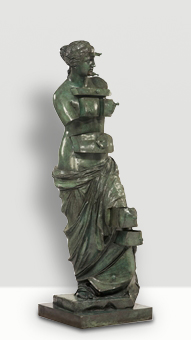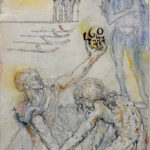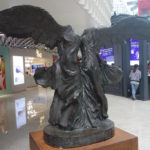Salvador Dali (Spanish, 1904-1989)
Vénus de Milo aux tiroirs
Signed ‘Salvador Dali’ (on the top of the base); numbered and stamped with foundry mark ‘VALSUANI CIRE PERDUE PARIS’ (on the left side of the base)
bronze with black and green patina
Height: 44.8 in. (114 cm.)
Conceived in 1964; this bronze version cast in 1988
PRICE: $225,000. USD
Property from a Private American Collection
Literature
M. Gérard, ed., Dalí, New York, 1968, no. 148 (another cast illustrated).
R. Descharnes, Dalí, The Work, The Man, New York, 1984, p. 199 (another version illustrated).
R. and N. Descharnes, Dalí, The Hard and the Soft, Spells for the Magic of Form, Sculptures & Objects, Paris, 2004, p. 37, no. 68 (another cast illustrated in color).
Exhibited
Paris, Centre Georges Pompidou, Musée National d’Art Moderne, Salvador Dalí Rétrospective 1920-1980, December 1979-April 1980, p. 233, no. 175 (illustrated).
Notes: Robert and Nicolas Descharnes have confirmed the authenticity of this sculpture.
Vénus de Milo aux tiroirs is perhaps Dalí’s most iconic sculpture. In the early 1940s Dalí’s artistic style shifted from Surrealism to a more traditional approach based on Classical and Renaissance art. As he famously stated, “to be a Surrealist forever is like spending your life painting nothing but eyes and noses.” Whereas Dalí’s previous works had been based on his interest in dreams and the subconscious, he now began to draw inspiration from historical and religious sources, appropriating traditional motifs and creating a daring and innovative visual vocabulary.
Obsessed with the image of the Venus de Milo, which he had viewed in the Louvre, Dalí reinterprets this classic image with a familiar passion for visual experiment and in doing so has created one of his most famous and recognizable motifs. Dalí has imbued the serene and sensuously feminine Venus with a new sense of character and presence, interrupting the smooth and diaphanous drapery with cube-like drawers set into the shape of her torso.
Two versions of this subject were executed in plaster, including the model for the present work. Dalí intended to include the bronze versions in his important 1964 retrospective in Tokyo at the Seibu Museum, but there was not enough time to cast them and only the plasters were exhibited. It was not until 1981 that the artist again attempted to cast the present work in bronze, but his frail health again delayed the process and they were eventually cast in 1988.






